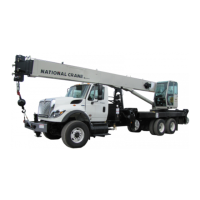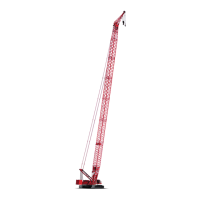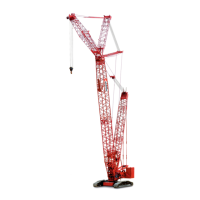Manitowoc Published 03-29-17, Control # 064-23 2-19
14000 OPERATOR MANUAL SAFETY INFORMATION
f. Place a warning sign at the start controls alerting
other personnel that crane is being serviced and the
engine must not be started. Do not remove sign
until it is safe to return crane to service.
2. Do not attempt to maintain or repair any part of the crane
while the engine is running, unless absolutely
necessary.
If the engine must be run, keep your clothing and all
parts of your body away from moving parts. Maintain
constant verbal communication between person at
controls and person performing maintenance or
repair procedure.
3. Wear clothing that is relatively tight and belted.
4. Wear appropriate eye protection and approved hard hat.
5. Never climb onto or off a moving crane. Climb onto and
off crane only when it is parked and only with
operator’s permission.
Use both hands and handrails, steps and ladders
provided to climb onto and off the crane.
Lift tools and other equipment which cannot be carried in
pockets or tool belts onto and off the crane with hand
lines or hoists.
6. The boom and gantry are not intended as ladders. Do
not attempt to climb lattice work of the boom or gantry to
get to maintenance points. If the boom or gantry is not
equipped with an approved ladder, lower them before
performing maintenance or repair procedures.
7. Do not remove cylinders until the working unit has been
securely restrained against movement.
8. Pinch points are impossible to eliminate; watch for them
closely.
9. Pressurized air, coolant, and hydraulic oil can cause
serious injury. Make sure all air, coolant, and hydraulic
lines, fittings, and components are tight and serviceable.
Do not use your hands to check for air, coolant or
hydraulic oil leaks:
• Use a soap and water solution to check for air leaks
(apply to fittings and lines and watch for bubbles)
• Use a piece of cardboard or wood to check for
coolant and hydraulic oil leaks
10. Relieve pressure before disconnecting air, coolant, and
hydraulic lines and fittings.
11. Do not remove the radiator cap while the coolant is hot
or under pressure. Stop the engine, wait until the
pressure drops and the coolant cools, then slowly
remove the cap.
12. Avoid battery explosion: do not smoke while performing
battery maintenance or short across battery terminals to
check its charge.
13. Read the safety information in the battery
manufacturer’s instructions before attempting to charge
a battery.
14. Avoid battery acid contact with skin and eyes. If contact
occurs, flush the area with water and immediately
consult a doctor.
15. Stop the engine before refueling crane.
16. Do not smoke or allow open flames in refueling area.
17. Use a safety-type can with an automatic closing cap and
flame arrestor for refueling.
18. Hydraulic oil can also be flammable. Do not smoke or
allow open flames in the area when filling hydraulic
tanks.
19. Never handle wire rope with bare hands. Always wear
heavy-duty gloves to prevent being cut by broken wires.
20. Use extreme care when handling coiled pendants.
Stored energy can cause the coiled pendants to uncoil
quickly with considerable force.
21. When inflating tires, use a tire cage, a clip-on inflator,
and an extension hose which permits standing well away
from the tire.
22. Only use cleaning solvents which are non-volatile and
non-flammable.
23. Do not attempt to lift heavy components by hand. Use a
hoist, jacks, or blocking to lift components.
24. Use care while welding or burning on the crane. Cover
all hoses and components with non-flammable shields
or blankets to prevent a fire or other damage.
25. T
o prevent damage to crane parts (bearings, cylinders,
swivels, slewing ring, computers, etc.), perform the
following steps before welding on crane:
• Disconnect all cables from batteries
• Disconnect output cables at engine junction box
• Attach the ground cable from the welder directly to
the part being welded and as close to the weld as
possible
Do not weld on the engine or engine mounted parts (per
engine manufacturer).
26. Disconnect and lock the power supply switch before
attempting to service high voltage electrical components
and before entering tight areas (such as carbody
openings) containing high voltage components.
27. When assembling and disassembling booms, jibs, or
masts on the ground (with or without support of boom

